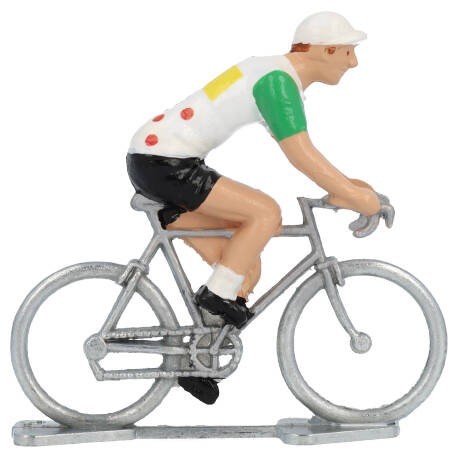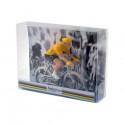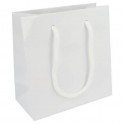No products
Combination jersey - Miniature cyclists
CJT
New product
Our miniature cyclists
Handpainted miniature cyclist with combination jersey.
-Completely produced out of metal: bike + cyclist
-Dimensions: height 50mm x width 50mm
-Weight: 23 grams
7 Items
- Remove this product from my favorite's list.
- Add this product to my list of favorites.
Data sheet
| Type | K |
| Posture | Standard |
| Gender | Male |
| Colour | Multi color |
| Period | 1981-1990 |
| Material | Zamac |
| Height | 50mm |
| Width | 50mm |
| Depth | 16mm |
| Weight | 23g |
| Painted | Cyclist |
More info
Greg Lemond
The combination jersey, also called the patch jersey, is the jersey that the leader in the combination classification in the Tour de France was allowed to wear. Was, because the combination classification no longer exists.
The combination classification was made by distilling a common classification from the other rankings: the polka dot jersey, the green jersey and the yellow jersey. But also the red jersey that existed between 1983 and 1989. Therefore the combination of red, yellow, green and Polka dots. In other words, the best all-rounder wore the combination jersey.
From 1968 to 1974, the leader of the combination classification wore the white jersey. The Italian Franco Bitossi was the first rider to win the combination jersey. From 1975 the best youngster in the Tour de France was allowed to wear this white jersey. The combination classification no longer existed. But in 1980 it was reintroduced. The classification was sponsored by the French TV channel TF1. The new name for the combination classification was the Grand Prix TF1. This formula would only exist for 3 Tours. From 1983 the combination classification was history again.
In 1985 the combination classification was reintroduced, and this time the winner wore the jersey with the different patches. The Dutchman Steven Rooks was the last wearer of the jersey in 1989. There were only 3 riders who ever won this jersey.
The winners of the combination classification:
1968 Franco Bitossi
1969 Eddy Merckx
1970 Eddy Merckx
1971 Eddy Merckx
1972 Eddy Merckx
1973 Joop Zoetemelk
1974 Eddy Merckx
1980 Ludo Peeters
1981 Bernard Hinault
1982 Bernard Hinault
1985 Greg LeMond
1986 Greg LeMond
1987 Jean-François Bernard
1988 Steven Rooks
1989 Steven Rooks
The opinions about the jersey are positive and negative. Many people found the jersey very ugly, a monstrosity that had all kinds of things. Others thought the patch sweater was a very colorful and a nice award for the best allround rider.
Such a classification still exists in the Giro and the Vuelta today.
The American Greg Lemond won the combination jersey 2 times. He was one of the first non-European riders from the American continent. From 1981 to 1994 he was active in the professional peloton. In 1983 he was the first non-European to win the World Championship. In 1986 he also became the first non-European to win the Tour de France.
The teams he rode for:
1981-1984 Renault Eleven
1985-1986 La Vie Claire
1987-1987 Toshiba-Look
1988-1988 PDM-Concorde
1989-1989 ADR-Bottecchia
1990-1990 Z-Tomasso
1991-1992 Z
1993-1994 Gan
In the years before his first Tour victory, he has been on the podium twice in Paris, 2nd and 3rd. In 1985 he rode for the same team as Bernard Hinault. Because of the team tactics he couldn't go all the way. But in 1986 he won the yellow jersey and the general classification. Just when his career was at its peak, he got injured. A few months later he was mortally wounded in a hunting accident. The 2 years that followed he could barely race. Many thought his carreer was over.
But in 1989 he returned to the start of the Tour. He won the individual time trial in the first week and made a big impression. It would be one of the most exciting tours ever. In the following stages Lemond and the Frenchman Laurent Fignon had the the yellow jersey. It was very close. One day Lemond had the jersey. The next day it was Fignon. Laurent Fignon seemed to be the best because he was very strong in the mountains. With only one stage to go, he was 50 seconds ahead of the American. This final time trial was about 24.5 km long.
Nobody put their money on Lemond. But in the time trial Lemond was a specialist. He introduced a new helmet and the triathlon steering wheel in the peloton. He won the time trial, and also the Tour de France. He won the Tour de France by only 8 seconds ahead of Fignon. This is still the smallest difference ever in Paris. In 1989 he became world champion again and a year later he won his 3rd Tour de France.
He won stages in the Tour de France, and also in the Giro. In 1985 he was third on the podium of the Tour of Italy. After his third Tour victory in 1990, no major successes followed for the American. In 1994 he stopped as a professional rider.
After his career he was active as an entrepreneur and producer of racing and spinning bikes. He also owns a restaurant and regularly appears in the media as a cycling commentator. He has also always been a major prosecutor of doping in the peloton. He accused Lance Armstrong and Floyd Landis of doping. It was proved that Lemond was right.
Most important victories:
1982 General classification Tour of the Future
1983 Final ranking Dauphiné Libéré
1983 World road champion
1984 Youth classification Tour de France
1985 General classification combination classification
1986 General classification Tour de France
1986 General classification combination classification
1989 General classification Tour de France
1989 World road champion
1990 General classification Tour de France
Discover our other miniature cyclists as well.
Accessories
Customers who bought this product also bought:
-
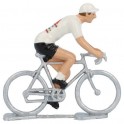
Cafe de...
Our miniature cyclist figurines Handpainted...
12,31 €
-
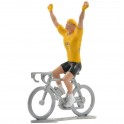
Yellow...
Our miniature cyclists A cyclist type winner...
16,45 €
-
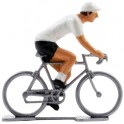
White jersey...
Our miniature cyclists Handpainted miniature...
12,31 €
-
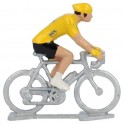
Yellow...
Our miniature cycling figures Miniature...
12,31 €
-
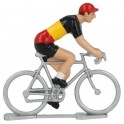
Belgian...
Our miniature cyclist figurines Handpainted...
12,31 €
-
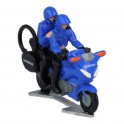
Motorbike...
All our motorcycles are hand painted.
41,24 €


